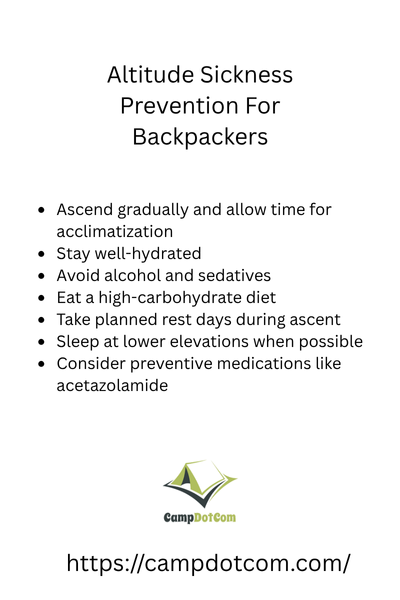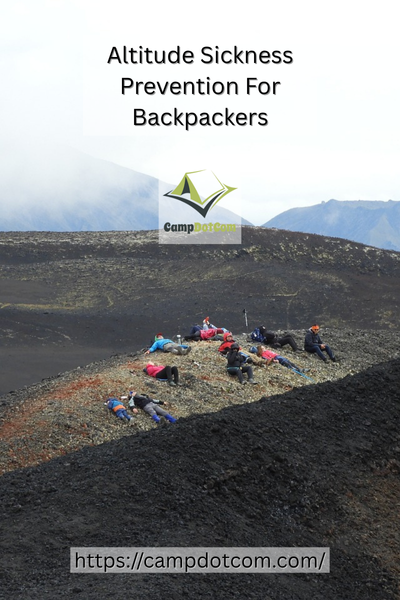Ever hiked up a mountain only to feel lightheaded, nauseous, or just completely off? That, my friend, is altitude sickness sneaking in. But no worries, I have you covered.
Let’s talk about altitude sickness prevention for backpackers so you can conquer those breathtaking peaks without, well, gasping for breath.
Read More About Altitude Sickness Prevention for Backpackers

What is Altitude Sickness, and Why Does it Happen?
Altitude sickness, or acute mountain sickness (AMS), happens when you ascend to high elevations too quickly.
As an Amazon Associate, I earn from qualifying purchases. Some of the links in this article are affiliate links. This means that, at zero cost to you, I will earn an affiliate commission if you click through the link and finalize a purchase.
Your body struggles to adapt to the lower oxygen levels, leading to symptoms like headaches, dizziness, nausea, and fatigue. And trust me, nothing ruins a hike faster than feeling like you’ve been hit by a truck.
More Things to Know About Altitude Sickness Prevention for Backpackers
I remember my first high altitude trek in Colorado. I was excited and ready to take on the trail until I hit about 10000 feet. Suddenly, my head felt like it was stuck in a vice and I was gasping like a fish out of water. Total beginner mistake? Definitely. But I learned my lesson. Let’s make sure you do not go through the same thing.

How to Prevent Altitude Sickness Before You Even Hit the Trail
The best way to handle altitude sickness? Avoid it altogether. Here’s how you can prep your body before heading up:
1. Take It Slow—Your Body Will Thank You
Your body needs time to get used to the thinner air. If you go from sea level to over 10000 feet in a single day, you are setting yourself up for trouble. It is best to spend a day or two at a moderate elevation before going higher. If that is not possible, try to take it slow and steady. Once you are above 8000 feet, keep your daily elevation gain to around 1000 feet.
2. Hydrate Like Your Life Depends on It (Because It Kind of Does)
Dehydration makes altitude sickness worse. Drink plenty of water before and during your hike. And no, chugging a bunch of coffee or beer doesn’t count. In fact, alcohol and caffeine can dehydrate you faster—so save that celebratory drink for after you’ve made it back down.
3. Fuel Up With the Right Foods
Your body needs plenty of energy to adjust to high altitudes. Eating a diet rich in carbohydrates before and during your trek can make a big difference. Carbohydrates help your body use oxygen more easily, which is super helpful when you are way up in the mountains. So go ahead and enjoy that extra bowl of pasta. It is actually working in your favor.
Staying Healthy While You’re on the Trail
Alright, you’ve prepped like a pro. Now let’s talk about what you should do once you’re out there.
4. Listen to Your Body—Seriously, Don’t Be a Hero
Altitude sickness is not something you can simply power through. If you start feeling unwell such as a headache, nausea, or dizziness, it is time to pause and check in with yourself. Rest, drink plenty of water, and if things do not improve, it is best to head to a lower elevation. The mountains are not going anywhere, but your well-being always comes first.
5. Consider Altitude Medications (If You Need Them)
Some people are more prone to altitude sickness than others. If you’ve had trouble in the past, talk to your doctor about medications like acetazolamide (Diamox). It helps your body adjust faster, but it’s not a magic cure—you still need to take things slow.
6. Breathe Deep and Take Breaks
It is easy to want to keep going, but pushing too hard when you are way up in the mountains can make you feel really sick. Take regular breaks, breathe deeply, and move at a comfortable pace. It is normal to feel out of breath at higher elevations, but do not ignore signs like dizziness or confusion. That is your body asking for a little extra care.
When to Call It Quits
Hiking at high elevations can be an unforgettable experience, but your safety always comes first. If you start noticing serious symptoms like confusion, trouble walking steadily, or vomiting, it is definitely time to head down. Ignoring these signs can lead to very dangerous conditions like high altitude pulmonary edema or high altitude cerebral edema. And honestly, those are not worth risking.
Staying Safe Above the Clouds Final Tips for Altitude Sickness Prevention
Altitude sickness prevention for backpackers is not just about making your hike more enjoyable. It is about keeping yourself safe. Take your time, drink lots of water, eat well, and pay attention to how you feel. If you do all that, you will be able to enjoy the beautiful views without feeling wiped out.
Hiking at high elevations is not only about reaching the top. It is about the adventure, the peaceful moments, and the joy of being out in nature. Go at your own pace, look around, and listen to what your body is telling you.
